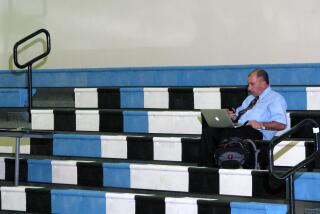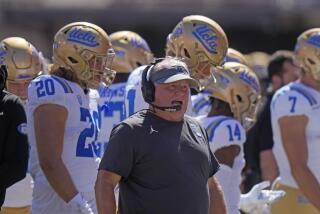Autumn of ’42 : Leahy Ditched Rockne’s System and Still Won
- Share via
For Notre Dame, this is the 50th anniversary of a pivotal football season.
It has been a half-century since Coach Frank Leahy, breaking with the traditions of Knute Rockne, breaking the hearts of some alumni and nearly breaking his health, converted the Irish to the T-formation.
No more radical or effective football action was ever taken at that university, except, possibly, in 1913, when Gus Dorais and Rockne, then a player, launched the era of the forward pass.
In the week of the 64th USC-Notre Dame game, Rockne’s strategic approach to football--as distinct from what he was and what he did to the Trojans and others--seems as dated as the leather helmet.
And to sports fans born since World War II, Leahy is nothing but a name, if that.
Yet football has never known two sounder strategists--or two bigger winners.
Leahy lost only 13 times in 13 years at Boston College and Notre Dame, where his two-school composite record was 107-13-9--.892.
Rockne’s 13-year record at Notre Dame was 105-12-5--.863.
Rockne (1888-1931) won three consensus national championships, one unanimously.
At Notre Dame, Leahy (1908-1973) won four consensus national championships, two unanimously.
Strangely, after all that--after Rockne’s rampage in the ‘20s and Leahy’s in the ‘40s--Rockne, alone, remains the legend.
That is not quite fair to Leahy, who, 50 years ago, just as he was getting started, was overtaken by one of the liveliest controversies in football history, a nationwide conflict between single-wing and T-formation advocates and their quarreling allies, coaches, fans and sportswriters.
Nowhere were things livelier than at Notre Dame in 1942 when Leahy, in his second season in Rockne’s old office, abandoned the successful offensive system that his old coach invented--a single-wing formation known as the Notre Dame box or Rockne shift--and put in the T.
“The alumni stood in line to crucify (Leahy) after our first game that year,” Ed (Moose) Krause, the school’s former athletic director, recalled the other day.
And it wasn’t even a defeat. It was a 7-7 tie at Wisconsin.
Within weeks, however, Leahy was on his way to two achievements that have been largely obscured by time, but which remain among the most remarkable in the long span of college football:
--As a champion, Leahy not only challenged Rockne but surpassed him in undefeated seasons: six in 11 years at Notre Dame for Leahy, five in 13 for Rockne.
--As a role model, Leahy was the pioneer who led football into the T-formation world, where it still lives. Not the inventor, he was the T-formation winner who, more than other coaches, made the new scheme acceptable, then fashionable and finally indispensable almost everywhere.
Winners influence others in football, and in the 1940s the most influential were Leahy and Army’s Red Blaik.
Said Krause, “They all saw that if you weren’t in the T, you weren’t going to outscore Leahy.”
T-formation football is so universal now that it is thought by the modern fan as simply football. But as a style, it is drastically different from the way the game was played before 1940, although the mechanical difference is a simple one.
In the Rockne system and other single- and double-wing styles that rose to prominence in the early years of the century, the center snapped the ball several yards into the backfield, usually to a halfback or fullback, much the way a center snaps it to the quarterback in the shotgun formation today.
Thus Notre Dame’s best runner, usually a halfback, was also required to be Rockne’s passer, despite a widely held theory that good runners are seldom good passers.
In T-formation football, by contrast, the center snaps the ball back to the quarterback--normally the best passer--who takes charge of the offense, throwing or handing off to better runners.
The creator of what is known as the modern T-formation was Clark Shaughnessy, a coach whose laboratories were the Chicago Bears and Stanford.
Shaughnessy incorporated the man-in-motion and other artistic weapons into the old T-formation, which, before the single-wing advent, was the way everybody played the game at the turn of the century, when football still was evolving.
Shaughnessy designed the Bears’ 1940s offense and coached Stanford’s, and in the winter of 1940-41, the Shaughnessy T electrified football. The Bears smashed the Washington Redskins in the NFL’s 1940 title game, 73-0, and Stanford beat Nebraska in the 1941 Rose Bowl, 21-13.
An authentic genius who later originated modern defense, Shaughnessy wasn’t very popular in his peer group. Thus the logic of the Shaughnessy T was resisted by college and pro coaches, who continued to hammer defenses with single-wing power plays.
Many of the best coaches, Bernie Bierman and Red Sanders among them, never did learn the T-formation, or convert to it.
The catalyst for national change was Leahy, who in his first six years in the T at Notre Dame, won four consensus national titles.
His championship years were 1943, ‘46, ’47 and ’49. Leahy was away in the Navy in ’44 and ’45. In 1948, Leahy finished 9-0-1, and USC, earning a 14-14 tie, knocked him out of the national championship in the last game.
Students who started at Notre Dame as freshmen in 1946 and graduated in ’50 never knew defeat. Leahy’s four-year streak of 38 games without a loss extended through their senior season in ’49.
By then, with Leahy and Blaik as two of their models, most college coaches had embraced the T-formation, and eventually most pro coaches followed suit.
“Leahy was personally close to Rockne,” said Krause, who began as a Notre Dame assistant coach in 1942. “When (Leahy was a player), Rockne used to take him to all the football clinics.
“Everyone wanted Rockne to explain the Notre Dame shift, and he and Leahy traveled all over the country (and) Leahy became very well known. So when he threw out the shift, everyone knew the T must be the real article.”
In 1941 at Notre Dame--the year before he threw it out--Leahy was 8-0-1 using Rockne’s offense. That was his first season there. He was only 33, and after that kind of early success, the average prudent young coach would have stayed with anything that had put him on top.
But there was nothing average about Leahy. Realizing quickly that Shaughnessy had the winning blueprint, Leahy spent the off-season between his first and second Notre Dame seasons learning the T.
Because it was so different from everything he knew about football, he forced himself to work on it continuously until, finally, it worked on his health.
“He came up with a nervous stomach,” Krause said. “He was afraid he was going to die--this young man (was) not yet 35. But that didn’t stop him.
“He stayed with us (assistant coaches) all day, showing us how to coach the T. Then he stayed up all night in his office, learning more about it.
“The (1942) season was barely under way before he was in the hospital. ‘Extreme nervous tension,’ they called it, and he missed three games. We finished 7-2-2.”
Some believed he was going backward. Leahy knew otherwise. Having mastered the new system in 1942, he rode it to the national championship in 1943 and on into a big future.
His staff, moreover, could point to one other rewarding accomplishment.
“It was a long time ago, 50 years ago, but I’ll never forget our 1942 game against Southern Cal,” Krause said. “That was the first year we used the T-formation, and we beat them, 13-0.”
More to Read
Go beyond the scoreboard
Get the latest on L.A.'s teams in the daily Sports Report newsletter.
You may occasionally receive promotional content from the Los Angeles Times.










